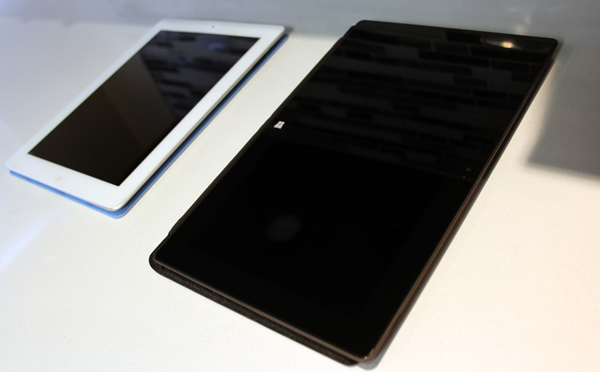With joy, great anticipation and yes, some dread, we recently received a Microsoft Surface RT tablet here in the office. Officially it is to be used strictly for testing and development. Unofficially, we simply use any excuse we can think of to get a new bit of technology on our desks. This goes double for mobile devices and triple for tablets.
If you wander the halls here, it is rare to go more than a few minutes without seeing someone walk by carrying an iPad. We ordered them the first day they were available back in April 2010 and we’ve been devoted users ever since. It is by far our customers most popular choice for running eWalk.
We’ve often found ourselves wishing we could take our much loved iPads even further.
As much as we use Apple devices here, our developers always keep a fixed and unwavering eye on Microsoft. For years we have stayed in lock step with their development of Windows OS and Internet Explorer. Windows and IE are the common tools used by our desktop clients so we are religious about keeping on top of each upcoming change.
Microsoft has promised that their new tablet will be ideal for serious work. This promise has generated a lot of excitement here at Media-X, as we’ve often found ourselves wishing we could take our much loved iPads even further.
The Surface certainly feels like serious business. It is a cool, solid slab of hardware, substantial and smooth like an ocean worn stone. A second generation iPad feels almost frail when compared to this tank of a tablet. Now, this isn’t necessarily a bad thing. You are given the sense that this tablet is intended for great things and weighty matters of importance. Good thing. I like to feel important. I can use all the help I can get.
More and more of our clients are accessing eWalkPLUS via the built in web browser on the iPad, so we take tablet web performance very seriously. Would Microsoft be able to keep pace with Apple on this front? Would the pages render correctly under IE10? We dove in to find out.
You’ll either be pleasantly surprised or absolutely horrified to find that ALL of your personal information comes over to this device.
Here’s a friendly piece of advice for anyone setting up a brand new Windows Surface Tablet RT. Make sure that you are absolutely, positively sure that you want to sync your Windows desktop system with it. If you opt to synchronize your machines, you’ll either be pleasantly surprised or absolutely horrified to find that ALL of your personal information comes over to this device.
All of it.
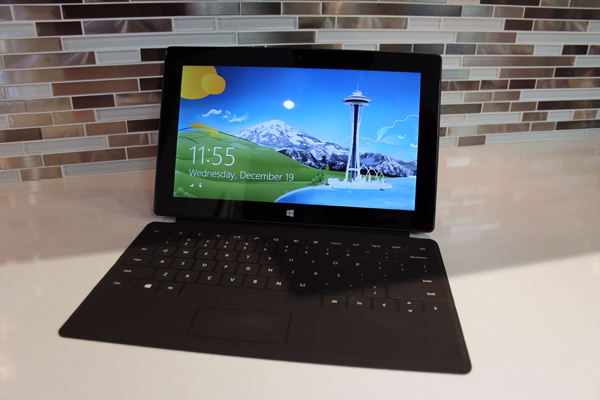
If you have a deep interest in the elaborate mating habits of brine shrimp, the whole office is about to find out. If that were to happen to a person (not me), I am sure that that person (still not me) might be quite traumatized by the event.
One oddity that I encountered while using the Surface has to do with its recharging state. If you’ve ever run the battery down on an iPad, you know that you need to either plug it into your wall or laptop to get it going again. Once you see that Apple logo pop back on the screen, you are good to go so long as you don’t unplug it. With the Surface, this wasn’t quite so smooth. My dead test unit needed to be recharged, so I plugged it back in via the provided power adapter. It sprang back to life almost immediately but as I started to use it, it struggled to keep ahead of demands and kept falling back to sleep. This happened over and over.
After a few vain attempts to work with it, I simply left it alone for a bit and gave it time. It seemed much happier the next time I tried it, and gave me no further troubles. Maybe I should learn patience. Maybe I should drink less coffee.
We splurged and bought ourselves a grey Type Cover to go with our Surface. We didn’t want to miss out on all the nifty clicking / clacking sounds that Microsoft promised in their advertising. This optional keyboard really does work surprisingly well. After a few hours of use, I can type at a reasonable rate with it, however I still need to keep a close watch on where my fingers are going.
Most of our clients use their tablets while conducting walkthroughs, they are up, moving on their feet wandering halls and classrooms. The real question was, how does the screen input measure up to the iPad?
The first thing I needed to get used to was the fact that the keyboard does not automatically come up whenever you enter a text field while using the desktop interface. “How… um…. do I type?” wasn’t a question that I’d expected to have when I first got started with this review. I was afraid to ask anyone out of fear of looking dumb, so I kept sadly poking it in the privacy of my office.
I’d grown so used to the Apple way of doing things, I’d stopped looking for any alternative way of doing things.
At first I thought it might have been the Type Cover keeping the onscreen keyboard from popping up. I detached it, still no joy. It wasn’t until I spied the keyboard icon in the bottom right that I realized that this was something I needed to explicitly call up or dismiss. I’d grown so used to the Apple way of doing things, I’d stopped looking for any alternative ways of doing things.
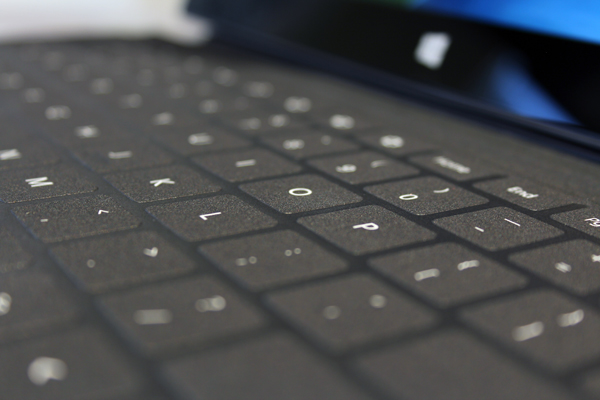
There’s nothing wrong with this approach, it’s just a different way of doing things. I’ve had plenty of occasions where I’ve been frustrated by Apple’s automatic keyboard popping up at inopportune times. For the record, the Metro browsing experience mimics the Apple approach of automatically calling pulling up the keyboard, so I suppose Microsoft has given us the best of both worlds.
I want to get on a plane and fly to Seattle just to thank the keyboard design team
I’m happy to say that the onscreen keyboard is a joy to type on. I preferred it to the iPad almost immediately. I want to get on a plane and fly to Seattle just to thank the design team for being smart enough to include arrows allowing you to move the text cursor back and forth. This is a godsend, and I’d forgotten how much I’d missed being able to do this when making a correction.
The touchscreen on the Surface is bright and very responsive. There’s a reassuring audible feedback whenever a key is pressed that I quite like. The space bar has its own different sound effect which gives you another clue as to how well your words are finding their way to the screen. Almost immediately, I found it to be a much more intuitive and enjoyable typing experience than the iPad. I imagine this is largely thanks to the wider screen (10.6 inches on the surface vs 9.7 inches on the iPad). This gives my fat fingers a lot more space to play.
How many hundreds of developer hours would it take to rework our applications to work properly under IE10?
The ability to quickly enter in notes is a key feature for our clients conducting staff appraisals on the go, so this is a critical item for any tablet our software runs on. Hopefully Apple will take some notes of this fine work and get to work on some changes of their own.
So here’s the main event: Our biggest reason for needing to get hold of a Surface was to see how the web browser experience would hold up. Would our clients be able to comfortably use eWalk and mVal via the Surface? Would IE10 throw our interfaces for any loops? How many hundreds of developer hours would need to be used to rework our applications to work properly under IE10? There was so much tension was in the air while I wrote this review.
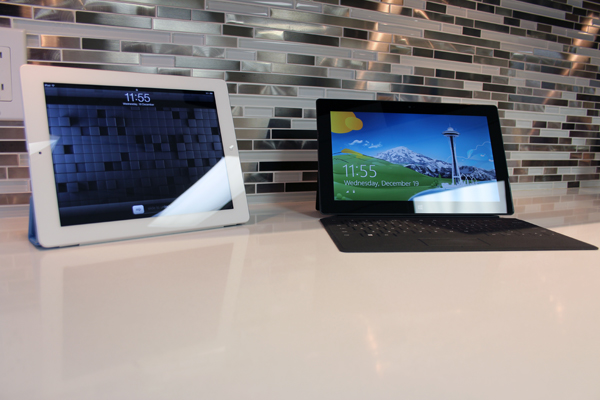
I’m happy to say that the web browsing experience under IE10 is near flawless. Our applications render beautifully, scrolling is like butter and pinch and zoom works great. The interface and render times are snappy and responsive. The more I use the Surface, the more appeal the screen holds for me. The colors look good, it is crisp and our interfaces look great. Maybe our developers had a little something to do with it, but I need to keep their egos in check so Microsoft gets the credit.
There’s something amazing to be had if you switch a Surface tablet over to desktop mode.
I’d hoped for a pleasant web experience from Microsoft, I got that and much more. There’s something amazing to be had if you switch a Surface tablet over to desktop mode. This view allows you to have multiple web windows open at the same time! After years of using an iPad, I had almost forgotten how handy this could be. It is very nifty to be able to pull up eTeacher’s comment library in a second window and keep working away on an elementary report card. I also like the way that .pdf’s are handled. If you download a form from our system on the iPad, the device assumes that you want to view it and will open it up full screen, not always ideal. The Microsoft Surface instead opens up a handy dialogue which asks you what you’d like to do. This is great if you want to simply download a copy of a form but don’t need to review it right then and there.
Speaking of downloads, the Surface gives you handy access to local files, something the iPad has very little in the way of support for. I could edit an Excel file right there on the tablet and use it to generate a staff import file for our system. No desktop required! File handling seems to be very well thought through. Looks like the originators of the very first “disk operating system” still know their stuff when come to users and files.
Everyone here on staff at Media-X is very interested to get their hands on the Surface Pro due out next year
Microsoft had a lot of courage to step up to the plate and take the iPad head on. While sales of the tablet haven’t exactly been stellar, even the most die hard Apple fan seems to be willing to agree that the Microsoft Surface is a device worthy of attention if not praise. I’m reminded of Microsoft’s first release of the XBOX back in 2001, it wasn’t a perfect release or a perfect device but they kept working on it and refining it. They went on to release the XBOX360 four years later which is, today, the number one selling console in North America. The same story may play out here.
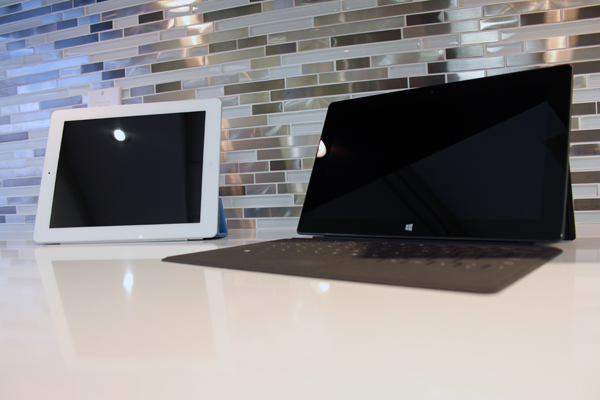
Everyone here on staff at Media-X is very interested to get their hands on the Surface Pro due out next year. Some have even gone so far to have sworn that they will buy it on day one. If this is the kind of interest that Microsoft has managed to generate with their first generation device, I think we’ll have a very interesting race ahead of us down the road. For now, we see the Surface as an excellent alternative to the iPad for users of our software. A little heavier perhaps, but that extra weight translates into a very solid user experience.

